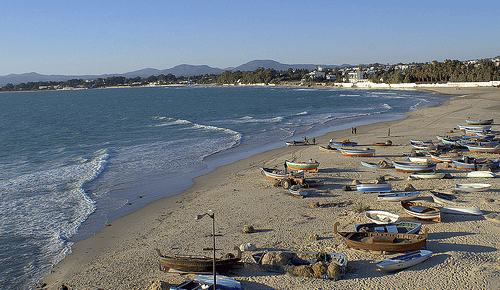
Sound, cost efficient management strategies in developed coastal zones can be reinforced by a thorough understanding of risks associated with the combination of anthropogenic and natural drivers of change.
In a paper recently published on Sustainability Science, a team of authors (among them, CMCC researchers Torresan S., Critto A., Marcomini A.) developed a Regional Risk Assessment (RRA) methodology for the assessment of the potential impacts of climate change in the Tunisian coastal zone of the Gulf of Gabes while focusing on sea-level rise and storm surge flooding impacts for human and natural systems, i.e., beaches, wetlands, urban areas, agricultural areas, and terrestrial ecosystems.
The abstract of the paper:
Sound, cost efficient management strategies in developed coastal zones can be reinforced by a thorough understanding of risks associated with the combination of anthropogenic and natural drivers of change. A Regional Risk Assessment (RRA) methodology was developed for the assessment of the potential impacts of climate change in the Tunisian coastal zone of the Gulf of Gabes. It is based on the use of Multi-Criteria Decision Analysis techniques and Geographic Information Systems and is designed to support the development and prioritization of adaptation strategies. The RRA focuses on sea-level rise and storm surge flooding impacts for human and natural systems, i.e., beaches, wetlands, urban areas, agricultural areas, and terrestrial ecosystems. Results suggest that for both of the studied climate change impacts, i.e., sea-level rise and storm surge flooding, the area potentially exposed is limited to a narrow, low elevation region adjacent to the shoreline. However, the exposed areas showed a high relative risk score, obtained by the integration of exposure and susceptibility factors. Beaches have the lowest relative risk scores, while wetlands and terrestrial ecosystems have the higher relative risk scores. The final outputs of the analysis (i.e., exposure, susceptibility, and risk maps) can support end-users in the establishment of relative priorities for intervention and in the identification of suitable areas for human settlements, infrastructure, and economic activities, thus providing a basis for coastal zoning and land-use planning.
Read the integral version of the paper
:
Rizzi J., Gallina V., Torresan S., Critto A., Marcomini A.
A Regional Risk Assessment addressing the impacts of climate change in the coastal area of the Gulf of Gabes
2015, Sustainability Science, DOI: 10.1007/s11625-015-0344-2.


